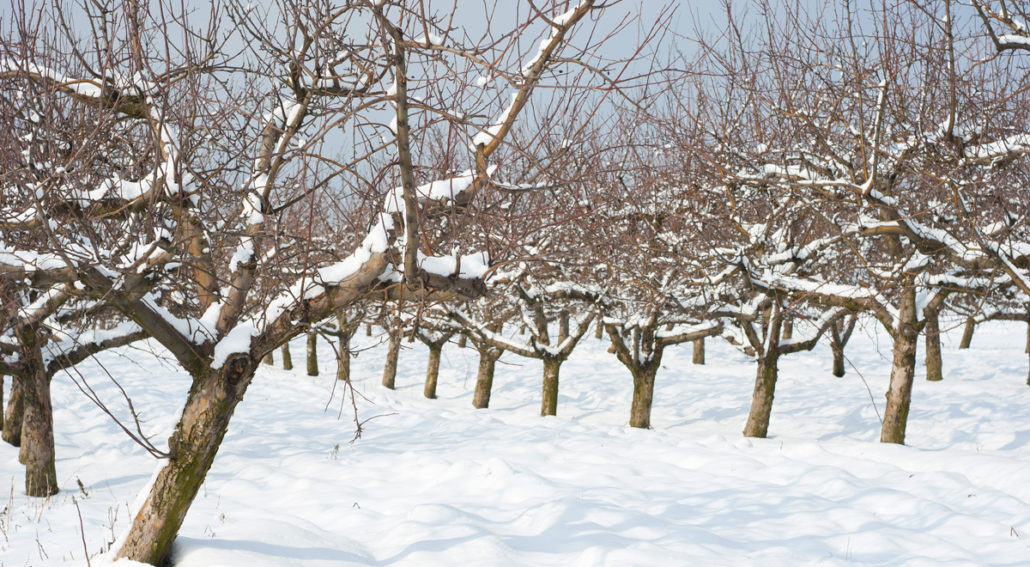GARDEN WORKS – Doctoring Trees: How to help them after a harsh winter

Has winter caused damage to your fruit trees?
 by Emily Cates
by Emily Cates
Are you feeling a little beat up from this winter? I sure am! And from the looks of it, so are a few of my fruit trees and a few more in the woods. While the promise of springtime is certain, it may be a while until it arrives. Until those glorious days arrive, we simply must endure.
Of course, we need not wait idly for springtime; there is plenty to do! And, the more we stay busy, the quicker it will seem to arrive. Look on the bright side: no bugs, scorching heat, or weeds to deal with! Also, the pace is much more relaxed and many activities can be done without as much competition from other chores. In this article, let’s look at something healing we can do in the meantime – giving attention to trees that need some help. After the windstorm last fall and other storms since, we’re sure to find something in our yards that needs TLC.
Sometimes it’s clear how to fix a broken tree, and sometimes it’s not. However you decide to care for them, use clean, sharp tools. Try to resist the urge to use a chainsaw when you can use hand tools, as that rips through branches as opposed to a clean cut. (Can you blame a tree for faring better with precision tools? Would you prefer a surgeon with a chainsaw or a scalpel?) Lop or saw damaged branches neatly to the “collar” from which they grew. When sawing, be sure to cut deeply from the bottom first a bit, then remove the saw and start again from the top side, sawing downward through the limb to eventually meet the cut made underneath. This will prevent tearing of the bark under the limb and damage to the good part of the tree when the limb falls off.
Oh no! What if the trunk of the tree is cracked or split? Some folks have had success from rather heroic efforts involving splinting, tying, cabling, and even duct taping. The sooner a damaged tree is repaired, the better a chance it has of healing. Don’t wait if you can help it. Your peach trees will thank you. Remember, though, not to leave on any items that could hinder the tree after it has healed, such as wire, rods, boards, rope and the like. If a tree is prone to damage, perhaps it needs to be pruned, supported, and fruits thinned. Or maybe it needs a better location, or a different tree altogether….
What if it’s not possible, despite our best efforts and intentions, to save a damaged tree? Well, maybe then it’s time for the chainsaw. Oftentimes a cut tree will sprout up and save itself with a little help. In grafted specimens, cut above the graft if possible and keep only sprouts that are growing above the graft. If this is not feasible, cut down to the part that is least damaged. Some folks insist in coating the wound with Treekote or something similar, but I don’t usually bother and let the tree heal itself. If all that is left is a stump and the tree decides to send up sprouts from the roots or base of the tree, select the most vigorous sprout and remove the rest. This sprout can be used as a rootstock onto which a desired variety can be grafted.
Well, I hope these activities help lessen the sting of a harsh winter and usher in the spirit of springtime. Enjoy the increasing sunshine as much as you can!
Responsible journalism is hard work!
It is also expensive!
If you enjoy reading The Town Line and the good news we bring you each week, would you consider a donation to help us continue the work we’re doing?
The Town Line is a 501(c)(3) nonprofit private foundation, and all donations are tax deductible under the Internal Revenue Service code.
To help, please visit our online donation page or mail a check payable to The Town Line, PO Box 89, South China, ME 04358. Your contribution is appreciated!


Leave a Reply
Want to join the discussion?Feel free to contribute!